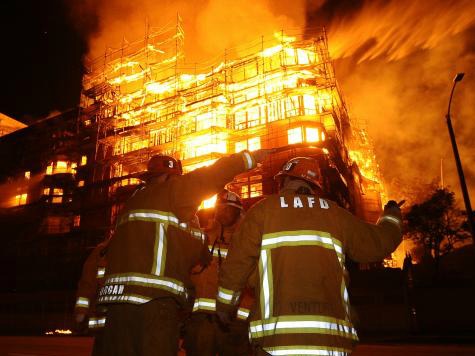LOS ANGELES, California — The developer behind downtown Los Angeles’s seven-story Da Vinci complex, one building of which was deemed a complete loss after a massive fire engulfed its wooden frame, has a history of building densely populated structures near highways. This is a testament to the increasing sparsity of land and rising costs which have pushed developers towards building in high-traffic areas that would otherwise be less desirable.
“When the economy is perceived as robust, and developers come out of the woodwork because inventories are low, they build wherever they can seek to make a profit,” said Sotheby’s International broker, Shamon Shamonki, to Breitbart News. “It’s an economic decision of availability.”
When searching for a residence, one cannot help but refer to the adage of “location, location, location.” And the sheer volume of noise and air pollution from vehicles that frequent areas that are in close proximity to freeways has always been a major source of contention. However, the influx of people coming to Los Angeles in search of a place to live has pushed many to bypass the criterion for residence. Shamonki says that clients are willing to “sacrifice specific location for general location,” and Da Vinci’s developer, Geoffrey H. Palmer, has maximized on that factor.
What sets Palmer’s developments apart is the number of units he has created around the four-level interchange in downtown Los Angeles. Palmer’s over-3,000 units, which are either developed or in the process of being developed, also include the likes of the 632-unit Medici Apartments (on South Bixel Street) and his 913-unit Lorenzo Apartments (on West Adams Boulevard, near the University of Southern California). Both of these structures are merely blocks away from the 110 Freeway entrance, and they mirror his Da Vinci complex.
“I think his style is kind of that Mediterranean look” that is emblematic of Southern California residential structures, said Matthew Chavez, who works as a realtor with Rodeo Realty.
Although the Da Vinci’s building B was completely destroyed in the flames, Palmer has stated on his website that his development’s unscathed building A will open as scheduled, in January of 2015.
The Los Angeles Fire Department has enlisted the help of the Bureau of Alcohol, Tobacco, Firearms, and Explosives (ATF) National Response Team in investigating the cause of the historic conflagration.
Palmer’s Da Vinci complex was met with great criticism earlier this year, particularly over his intent to build a pedestrian bridge allowing residents to bypass the streets below; the move was seen as “anti-homeless” people. Downtown Los Angeles is still in the development process as it seeks to build an image to mirror what Manhattan, New York, has achieved.
The LAFD has been treating the investigation as criminal and has not yet ruled out terrorism.
Follow Adelle Nazarian on Twitter @AdelleNaz.

COMMENTS
Please let us know if you're having issues with commenting.